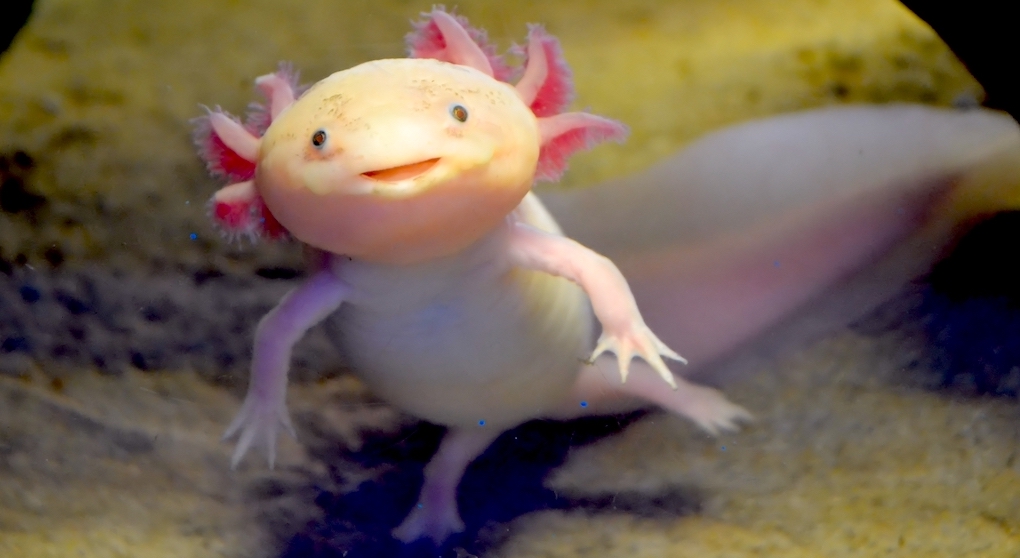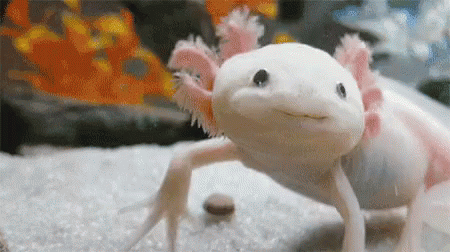
The axolotyl might look like a derpy little water baby, but behind its endearing smile is a vast and important secret. These rare Mexican salamanders possess one-of-a-kind healing powers that may be the key to treating human diseases and traumatic injury.

The axolotyls (Ax-uh-LOT-ul) is unique among amphibians. While other salamanders can regrow a lost limb, the axolotl can heal any kind of damaged tissue. Not only can an axolotyl regrow an amputated limb complete with bones, muscles and nerves, but it can repair its own heart, brain, lungs and other organs. Crush or sever its spinal cord, and a month later it’ll be swimming around again like nothing happened. Axolotl tissue is also incredibly resistant to the spread of cancer. No other organism on earth can match this ability.

Another thing which makes axolotls unique is that they remain in the larval stage their entire lives (up to 25 years). Instead of developing lungs and moving onto land like other amphibians, axolotls retain their shroud of feathery gills and live underwater. This is thought to be an evolutionary advantage, since being underdeveloped meant they required less food to survive and didn’t need to compete with other land dwellers.

Tiny Grins; Giant Genome
Don’t let their derpy little faces fool you. The axolotl has a remarkably complex genome. In fact, at 32 million base pairs, it is ten times longer than yours!
In fact, the axolotl genome is actually the longest that scientists have ever sequenced. Researchers have been studying axolotls in laboratories for over 150 years, hoping to understand the source of their amazing regenerative abilities.

Understanding Their Powers
At first, researchers believed that pluripotent stem cells were produced at the site of injury. These special “blank slate” cells can turn into any other kind of cell, such as skin cells or blood cells.
But in 2009, new research showed that the regenerating tissue grows from its own kind of cell. Damaged muscles regrow more muscle. Bone grows more bone. This regeneration is not all that different from the process that happens in our own embryonic development. Even the fingertips of small children can grow back, an ability that is lost as we get older.

Since axolotls stay in the larval stage of development their entire lives, this embryonic ability seems to be retained. But it is still not clear how the process works. Within the massive axolotl genome, researchers are looking for the genes responsible for communicating the recipe for regrowth. If they can understand that, they might be able to find out how to switch those processes back on in humans.
One promising line of research surrounds the enzyme amblox, which is produced at the site of injury in the axolotl, and seems to be involved in signaling regeneration. Early tests on humans show that applying artificial amblox to wounds does cause skin to grow back faster. One day, a form of amblox could be used to repair severely burned skin – or even regrow an amputated limb.


The Future for Axolotls
Sadly, in the wild, axolotls are nearly extinct. Their only natural habitat is Lake Xochimilco, near Mexico City. The lake is badly polluted and despite their healing powers, axolotls cannot keep up with the damage caused by high levels of toxins. They are also threatened by foreign species that have been introduced into the lake for fishing. Axolotls are even preyed on for human consumption, as they are considered a delicacy in Mexico.

Fortunately, if their goofy grins aren’t enough to move us into protecting them, their scientific importance to us might. In the distant future, scientists hope we may harness the axolotl’s ability to heal any kind of tissue, with targeted gene therapy that reverses the damage caused by heart attack, stroke, spinal cord injury, cancer, and myriad other conditions. This could reverse the effects of aging and extend the human lifespan.
But while it may be some time before we adopt their magic healing powers, we can still take a page out of the axolotl’s book: When life gets you down, just smile and keep on swimming.

Recommended Resources
Video: “Axolotls Are Masters of Regeneration” by Animalogic
Video: “Axolotl Care Guide” by Girl Talks Fish
“The axolotl genome and the evolution of key tissue formation regulators” Nature (2018) – Research report on sequencing of axolotl genome
